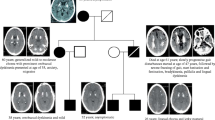Abstract.
Hereditary haemochromatosis (HH) is a common autosomal recessive systemic iron overload disorder in which CNS manifestations, particularly movement disorders, have been reported. We report a 63-year-old woman with familial HH with a four-year history of progressive gait disturbance, chorea, and mild cervical and laryngeal dystonia. Her movement disorder was thought to be related to the haemochromatosis. On further investigation, analysis for the Huntington’s disease expansion was positive. A review of the seven published cases of movement disorders associated with HH as well as data concerning brain iron deposition in this condition leads us to debate the causal link between movement disorders and HH. We suggest that movement disorders are rare in association with HH, and that such patients should be thoroughly investigated for another cause for their movement disorder.
Similar content being viewed by others
References
Ajioka RS, Kushner JP (2002) Hereditary Hemochromatosis. Semin Hematol 39(4):235–241
Berg D, Hoggenmuller U, Hofmann E, Fischer R, Kraus M, Scheurlen M, Becker G (2000) The basal ganglia in haemochromatosis. Neuroradiology 42:9–13
Cammermeyer J (1947) Deposition of iron in the paraventricular areas of the human brain in hemochromatosis. J Neuropathol Exp Neurol 6:111–127
Demarquay G, Setiey A,Morel Y, Trepo C, Chazot G, Broussolle E (2000) Clinical Report of Three Patients With Hereditary Hemochromatosis and Movement Disorders. Mov Disord 15:1204–1209
Hanson EH, Imperatore G, Burke W (2001) HFE gene and hereditary hemochromatosis: a HuGE review. Human Genome Epidemiology. Am J Epidemiol 154(3):193–206
Jones HR Jr, Hedley-Whyte ET (1983) Idiopathic hemochromatosis (IHC): dementia and ataxia as presenting signs. Neurology 33:1479–1483
McDougal DB, Adams RD (1950) The neuropathological changes in hemochromatosis. J Neuropathol Exp Neurol 9:117–118
Moos T (2002) Brain iron homeostasis. Dan Med Bull 49:279–301
Moos T, Trinder D, Morgan EH (2000) Cellular distribution of ferric iron, ferritin, transferrin and divalent metal transporter 1 (DMT1) in substantia nigra and basal ganglia of normal and beta2-microglobulin deficient mouse brain. Cell Mol Biol 46:549–561
Nielsen JE, Jensen LN, Krabbe K (1995) Hereditary haemochromatosis: a case of iron accumulation in the basal ganglia associated with a parkinsonian syndrome. J Neurol Neurosurg Psychiatry 59:318–321
Powell LW, Isselbacher KI (1998) Hemochromatosis. In: Harrison’s Principle of Internal Medicine (14th edition). McGraw-Hill, New York
Rouault TA (2001) Systemic iron metabolism: a review and implications of brain iron metabolism. Pediatr Neurol 25:130–137
Schroder J, Haan J (1987) Extrapyramidal syndrome in idiopathic hemochromatosis. Significance of laboratory chemical, neurophysiologic and imaging procedures. Nervenarzt 58:577–578
Scully RE, Galdabini JJ, McNeely BU (1979) Case records of the Massachusetts General Hospital.Weekly clinicopathological exercises. Case 17–1979. N Engl J Med 300:969–976
Author information
Authors and Affiliations
Corresponding author
Rights and permissions
About this article
Cite this article
Russo, N., Edwards, M., Andrews, T. et al. Hereditary haemochromatosis is unlikely to cause movement disorders. J Neurol 251, 849–852 (2004). https://doi.org/10.1007/s00415-004-0445-9
Received:
Revised:
Accepted:
Issue Date:
DOI: https://doi.org/10.1007/s00415-004-0445-9




